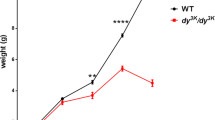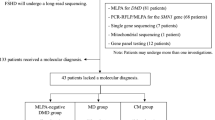Abstract
X-LINKED Duchenne muscular dystrophy is a serious genetic disorder for which at present there is no effective treatment. It is characterised by progressive muscle wasting and weakness which first becomes apparent around the age of 3–5 years, leading to death usually before the age of 20 (ref. 1). A proportion of female heterozygous carriers have significantly elevated serum levels of creatine kinase and a woman who is found to be at high risk of having an affected son can elect to have amniocentesis with antenatal foetal sexing and selective abortion of any male foetus. A proportion of such aborted foetuses will, however, be normal but since the cause of the disorder is not known it is not yet possible to diagnose an affected male foetus in utero. As a first step in this direction we have examined the muscle histology and levels of creatine kinase in serum, muscle and amniotic fluid in a number of therapeutically aborted male foetuses at risk for Duchenne muscular dystrophy. We report that muscle histology, and possibly the serum level of creatine kinase, may be abnormal in this disorder even by the second trimester of pregnancy.
This is a preview of subscription content, access via your institution
Access options
Subscribe to this journal
Receive 51 print issues and online access
$199.00 per year
only $3.90 per issue
Buy this article
- Purchase on Springer Link
- Instant access to full article PDF
Prices may be subject to local taxes which are calculated during checkout
Similar content being viewed by others
References
Emery, A. E. H. & Wilson, J. N. Prog. med. Genet, 7, 116–145 (1967).
Streeter, G. L. Contrib. Embryol. 11, 145–170 (1920).
Rosalki, S. B. J. lab. clin. Med. 69, 696–705 (1967).
Papadopoulos, N. M., Hess, W. C., O'Doherty, D. & McLane, J. E. Clin. Chem. 5, 569–574 (1959).
Vassilopoulos, D., Lumb, E. M. & Emery, A. E. H. J. Neurol. Neurosurg. Psychiat. 39, 159–162 (1976).
Pearson, C. M. Brain 85, 109–120 (1962).
Hudgson, P., Pearce, G. W. & Walton, J. N. Brain 90, 565–576 (1967).
Bradley, W. G., Hudgson, P., Larson, P. F., Papapetropoulos, T. A. & Jenkison, M. J. Neurol. Neurosurg. Psychiat. 35, 451–455 (1972).
Toop, J. & Emery, A. E. H. Clin. Genet. 5, 230–233 (1974).
Heyck, H., Laudahn, G. & Carsten, P. M. Klin. Wschr. 44, 695–700 (1966).
Beckmann, R. & Scheuerbrandt, G. Kinderarzt. 7, 1267–1272 (1976).
Vassilopoulos, D. & Emery, A. E. H. J. med. Genet, 14, 13–15 (1977).
Author information
Authors and Affiliations
Rights and permissions
About this article
Cite this article
EMERY, A. Muscle histology and creatine kinase levels in the foetus in Duchenne muscular dystrophy. Nature 266, 472–473 (1977). https://doi.org/10.1038/266472a0
Received:
Accepted:
Published:
Issue Date:
DOI: https://doi.org/10.1038/266472a0
This article is cited by
-
Is it the right time for an infant screening for Duchenne muscular dystrophy?
Neurological Sciences (2020)
-
Detection of collagens by multispectral optoacoustic tomography as an imaging biomarker for Duchenne muscular dystrophy
Nature Medicine (2019)
-
Dp412e: a novel human embryonic dystrophin isoform induced by BMP4 in early differentiated cells
Skeletal Muscle (2015)
-
Duchenne muscular dystrophy: Pathogenetic aspects and genetic prevention
Human Genetics (1984)
Comments
By submitting a comment you agree to abide by our Terms and Community Guidelines. If you find something abusive or that does not comply with our terms or guidelines please flag it as inappropriate.



